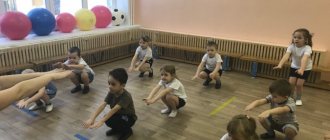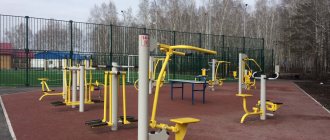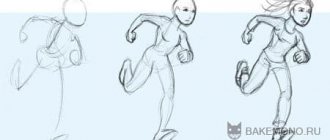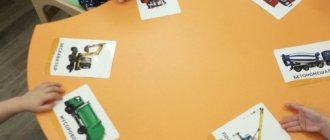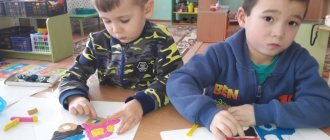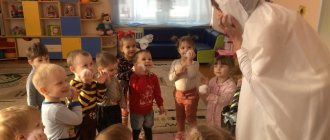Summary of GCD on physical development in the middle group
Author: Khmarina Elena Valentinovna
Summary of GCD on physical development in the middle group
Objectives:
Educational:
Exercise children in walking one after another, in a snake, lining up in a circle, walking with high knees, and doing pull-ups on a gymnastic bench.
Developmental:
Develop agility, endurance, motor activity.
Educational:
Cultivate interest in physical development activities, a sense of mutual assistance, and a friendly attitude.
Health savings
: Strengthen the respiratory system, promote the formation of correct posture, hardening the body, and prevent flat feet.
Equipment:
Gymnastic benches, sandbags, musical accompaniment, basket with a letter, rope.
1 part.
Progress of the NOD:
Children enter the hall to the music and form a circle.
Educator:
“Do you guys like fairy tales?
(Children's answers)
Do you want to go to a fairy forest?
(Children's answers)
Let's go together along the path into the forest! “The children follow the teacher and follow each other in a circle. The music ends and the children stop.
Educator:
“Here we come to the forest. Hello forest, dense forest! Full of fairy tales and miracles! There’s a swamp ahead... How can we get through it?” Sandbags are laid out in front of the children to get through the “swamp”; children step over the bags.
Educator:
“Try to walk in such a way that you don’t go off the road.” When everyone has overcome the obstacle, the teacher picks up a pre-prepared basket with a letter in it.
Educator:
“We walked through the swamp and found the basket!” They read the letter: “There was a little house in the forest, animals lived there, and when I got to them, the little house suddenly fell down! Help! Help! Give us back the little house!”
Educator:
“Let's help the animals!
(Children's answers)
To do this, you need to find a clearing and build a tower! Go ahead! There is a river in front of us, we need to cross the bridge!” Children approach the bench.
Educator:
“There is a bridge on the way that you have to crawl along! Reach straight with your hands and grab the bridge! Don’t put your feet down, raise your head up!” Children approach the stream (rope).
Educator:
“We can’t go any further, a stream is babbling on the way! Raise your legs higher, step over the stream!” They move on like a snake.
Educator:
“There’s a clearing ahead, the sun is shining! It also helps the guys in the forest!”
Part 2.
ORU:
1.
Starting position
- legs together, hands on the belt.
Educator:
“We looked at the sun, and the rays warmed us!”
Children on their toes reach for the “sun” (4-6 times) 2. I.p - legs together, arms to the sides. Educator:
“The breeze flies by, the trees in the forest sway.” Tilt left to right (8-10 times).
3. Starting position
- legs together, arms down.
Educator:
“Look at the bottom guys, there are mushrooms growing - honey mushrooms! We must also collect them and then give them to the animals.” Bend forward (6-8 times).
Educator:
“We had a good walk and weren’t tired at all! We’ll take the tools and build a home for the animals.”
ATS:
1.
“Sawing”
-
Starting position
: arms bent at the elbows, legs apart.
We imitate the movements of a saw. 2. “Chop”
-
Starting position
of the arm above the head in a lock, legs apart.
Bend forward, swing your arms between your legs. 3. “We hammer in nails”
-
Starting position:
legs together, hands on the belt. On the count of 1,2,3,4, children perform jumps.
Educator:
“So the little mansion has grown, It is not low, not high!
Animals will live in it! Who will live there? (Children's answers.)
Children imitate the movement of animals from a fairy tale.
Part 3.
Educator: “The butterflies have arrived and warmed their wings!”
Outdoor game “Butterflies and the Sun”. (Sun - butterflies fly, rain - butterflies stop and hide their wings.)
Reflection.
Educator:
“We were all friendly, brave, skillful, and so we built a little house in a fairytale forest!
Now it’s time for us to return” comments powered by HyperComments
Text of the book “Physical education in kindergarten. System of work in the middle group"
Lesson 18**
Tasks.
Exercise children in walking, performing various jumping tasks, and strengthen the ability to act on a signal.
Part I.
Forming in a column one at a time, walking and running in a column one at a time. At the teacher’s signal, children perform the following tasks while walking: arms to the sides, on the belt; clapping your hands. Running on your toes alternating with regular running.
Part II.
Game exercises.
“Throw it, catch it.” Children, in a scattered formation, throw the ball up and catch it with both hands, trying not to press the ball to their chest or drop it on the floor.
“Who is faster” (relay race). Children are divided into two teams and lined up in two columns. A starting line is marked in front of each team; two objects (a cube or pin) are placed at a distance of 3 m from the line. The first child in each column runs with the ball in his hands to the object, then goes around it and returns to his column, passing the ball to the next player. The teacher announces the winning team. Repeat 2-3 times.
Outdoor game "Traps". Children are on one side of the hall behind the conventional line. They are given the task: to run to the next conditional line (to the other side of the hall) so that the driver, who is in the center of the hall, does not have time to insult anyone. After the teacher’s words: “One, two, three – run!” - the children run to the other side. The one who is touched by the trap is considered caught and moves aside. After two runs, those caught are counted and another driver is selected.
Part III.
Walking in a column one at a time. The smartest trap is ahead.
Lesson 19
Tasks.
Repeat walking in a column one at a time to develop eye control and rhythm when stepping over the bars; practice rolling the ball in a straight direction and climbing in an arc.
Part I.
Walking in a column one at a time, walking with stepping over bars placed at a distance of two steps for the child. The teacher reminds the children that they must step over the bars alternately with their right and left feet. After the last child in the column finishes the exercise, the command is given to run in all directions throughout the hall. Walking and running exercises alternate. Formation in a circle.
II .
General developmental exercises with a ball.
1. I. p. - stand with your feet as wide as your feet, holding the ball down in both hands. Raise the ball forward, up; lower the ball, return to the starting position (5-6 times).
2. I. p. – stand with feet shoulder-width apart, ball in both hands near the chest. Bend over, roll the ball from your right foot to your left, rise, return to the starting position (5-6 times).
3. I. p. - sitting, legs apart, ball in both hands in front of you. Bend over, touch the ball to the floor as far as possible, straighten up, return to the starting position (5-7 times).
4. I. p. - kneeling, sitting on your heels, ball in both hands in front of you. Roll the ball around yourself to the right and left, turning it over with your hands (3 times in each direction).
Main types of movements.
1. Rolling the ball in a straight direction (3 times).
2. Climb under the cord without touching the floor with your hands (3-4 times).
The teacher places two stands and pulls the cord at a height of 50 cm from the floor level. Children are arranged in a line, each child has a ball in his hands. The task is given: approach the cord, sit down and group it into a “lump”, and then walk under the cord, without touching the floor, with a ball in your hands - 3 times in a row. Then, at the teacher’s signal, the children take their starting position (feet shoulder-width apart), bend over, roll the ball forward with an energetic movement and run after it.
Outdoor game “At the bear in the forest.”
III .
Low mobility game “Guess where it’s hidden.”
Lesson 20*
Main types of movements.
1. Climbing under an arc (4–5 arcs) with two columns in a continuous manner (3–4 times).
2. Jumping on two legs through 4-5 lines (3-4 times).
3. Tossing the ball with both hands (the balls lie in 2-3 large diameter hoops). Children approach the hoops, take the balls and, at the teacher’s signal, practice throwing up and catching the ball with both hands.
Lesson 21**
Tasks.
Exercise children in walking and running between objects placed randomly throughout the playground; in rolling hoops, in jumping forward.
Part I.
Walking in a column one at a time, at the teacher’s signal, switch to walking between cubes placed in random order, then running between objects.
Part II.
Game exercises.
"Ride it - don't drop it." Children line up in two lines, one opposite the other at a distance of 2 m. Children in one line have hoops in their hands. At the teacher’s signal (after demonstration and explanation), the players roll the hoops to the opposite side. The children in the second rank catch them, preventing them from falling. Then the second group of children completes the task, and so on several times in a row.
"Along the path." The teacher draws or lays out two paths (20 cm wide) from cords and invites the children to jump along the path on two legs. The exercise is performed in two columns (3-4 times).
Outdoor game "Colored Cars".
Part III.
Walking in a column one at a time - “the cars went to the garage.”
Lesson 22
Tasks.
Practice walking and running in a column one at a time, walking and running in all directions; repeat climbing under an arc without touching the floor with your hands; practice maintaining balance when walking on a reduced support area.
Part I.
Forming in a line, checking posture and alignment; walking and running in a column one at a time, walking and running in all directions.
Part II.
General developmental exercises with skittles.
1. I. p. – stand with legs apart, pin in the right hand. Raise your arms up through your sides, transfer the pin to the other hand, lower the pin.
2. I. p. – stand with feet shoulder-width apart, pin in the right hand. Lean forward, place the pin near your left foot. Straighten up, hands on your waist. Lean forward, take the pin with your left hand, straighten up. Do the same for the right leg (3 times for each leg).
3. I. p. - kneeling, pin in the right hand, left on the belt (Fig. 4). Turn right (left), take the pin (3 times in each direction).
Rice. 4
4. I. p. – leg stand at the width of the foot, pin in the right hand. Sit down, put the pin on the floor, stand up, straighten up, hands behind your back. Sit down, take the pin. Return to starting position (5-6 times).
5. I. p. - standing near the pin, legs slightly apart, arms at random. Jump on two legs around the pin in both directions (2-3 times in each direction).
Main types of movements.
1. Climb under the arch (height 50 cm), touching with hands (3-4 times).
2. Balance - walking on a board (15 cm wide) placed on the floor, stepping over cubes placed at a distance of two child steps (3-4 times).
3. Jumping on two legs between medicine balls (4-5 pieces) placed in two lines (3-4 times).
Exercises in balance, climbing, and jumping are performed in a continuous manner. First, the teacher shows the exercises using the example of two children. Climb under an arc in two columns without touching the floor with your hands (3-5 arcs in a row at a distance of 0.5 m from one another); walking on the board, stepping over the cubes, arms to the sides; Jumping on two legs between medicine balls.
Outdoor game "Cat and Mice".
Part III.
Game "Guess who called?"
Lesson 23*
Main types of movements.
1. Climb under a cord stretched at a height of 40 cm, with a ball in your hands, then straighten up, lift the ball up, and lower it (3-4 times).
2. Roll the ball along the track (25 cm wide) in a straight direction, then run after the ball along the track (2-3 times).
Organization during exercises depends on the availability of benefits, the number of children in the group, and their physical fitness.
Lesson 24**
Tasks.
Repeat walking and running in a column one at a time; practice throwing a ball into a basket, developing dexterity and eye.
Part I.
Walking in a column one at a time, switching to walking with high knees, hands on the belt - “like horses”; running in all directions; walking and running are carried out in alternation.
Part II.
Game exercises.
“Throw it, catch it.” The teacher invites each child to take a ball (medium diameter) and disperse across the entire playground. Children perform an exercise in throwing a ball up and catching it with both hands, each at their own pace (3-5 tosses, then pause and repeat, and so on several times).
"Ball in the basket." Children stand in three circles at a distance of 2 m from the center of the basket. Task: throw the ball into the basket with one hand from below. The team that scores more goals is considered the winner. The exercise is repeated 4–5 times.
“Who is more likely to follow the path?” Two paths (25 cm wide) are laid out from cords or ropes. Children in two columns perform jumps on two legs, moving forward along the path, trying not to touch the cord. The team with the largest number of guys completing the task quickly and correctly wins.
Outdoor game "Horses". Children are divided into two equal groups: some children pretend to be horses, others – grooms. Each groom has jump rope reins. At the teacher’s signal, the “grooms” harness the “horses” (put reins and jump ropes on them). According to the following instructions from the teacher, the children first move at a walk, raising their legs high at the knees, then start running (in different directions) so as not to interfere with each other. After some time, the “horses” stop, they are unharnessed and released into the meadow, the “grooms” also rest. At the teacher’s signal, the children change roles and again perform walking and running exercises. The game is repeated several times with different game plots (horses ride for hay, for firewood, etc.).
Material to repeat
1st week.
Game exercises. Walking and running: “Traps”, “Horses”, “Traps - dashes” (running from one end of the site to the other). Balance – walking along a path while stepping over cubes (bars); walking and running between objects placed in one line;
walking on a gymnastic bench (“bridge”). Jumping: on two legs, moving forward, between objects placed in one row (skittles, balls, cubes); jumping around a ball or cube. Outdoor games: “Cat and Mice”, “Find a Mate”, “At the Bear in the Forest”.
2nd week.
Game exercises. A cord in the form of a circle is placed on the platform, with a driver in it. The players are outside the circle and jump on two legs into the circle, and as the driver approaches, they jump back. The driver is trying to make someone look bad. The upset player changes places with the driver. The game repeats itself.
Jumping on two legs with a ball in your hands - at the teacher’s signal you need to stop, put the ball on the floor and walk around it.
Throwing balls to each other over the net with both hands from behind the head. Crawling on all fours with support on your palms and knees, pushing a medicine ball with your head and moving forward (distance 3 m).
Outdoor games: “Tram”, “Colored Cars”, “Cat and Mice”.
3rd week.
Game exercises. Rolling the ball at the teacher’s signal and running after it; rolling balls to each other (methods: sitting, legs apart, kneeling, sitting on your heels).
Crawling on all fours (with a bag of sand on your back).
Outdoor games: “Cucumber, cucumber...”, “Cat and Mice”, “Cars”.
4th week.
Game exercises. Crawling – “Crawl along the path (board, bench)” with support on your palms and knees; climbing a hoop with a ball (cube) in your hands, without touching the floor with your hands. Balance – walking along a path, stepping over objects; walking on a gymnastic bench sideways with an extended step.
Outdoor games: “Horses”, “By the Bear in the Forest”, “Horses”, “Traps”.
November
Lesson 25
Tasks.
Exercise children in walking and running between objects; in jumping on two legs, to consolidate the ability to maintain stable balance when walking on an elevated support.
Part I.
Walking and running between cubes placed randomly throughout the room, trying not to touch each other and the cubes. Repeat 2-3 times. Construction around the cubes.
Part II.
General developmental exercises with a cube.
1. I. p. – leg stand at the width of the foot, cube in the right hand. Raise your arms up through your sides, transfer the cube to your left hand, lower your arms. Raise your arms across your sides and pass the cube from your left to your right hand (4-5 times).
2. I. p. – leg stand at the width of the foot, cube in the right hand. Sit down, put the cube on the floor, stand up, hands on your belt. Sit down, take the cube, straighten up, return to the starting position (5-6 times).
3. I. p. - kneeling, cube in right hand. Turn to the right (left), place the cube at the toes, straighten up, return to the starting position (3 times in each direction).
4. I. p. - sitting, legs apart, cube in right hand. Lean forward, place the cube at the toe of your right (left) leg, straighten up, hands on your waist. Lean forward, take the cube, return to the starting position (5-8 times).
5. I. p. - legs slightly apart, arms at random, cube on the floor. Jumping on two legs around the cube in both directions, alternating with a short pause.
Main types of movements.
1. Balance - walking on a gymnastic bench, stepping over cubes placed at a distance of two child steps (2-3 times).
2. Jumping on two legs, moving forward between cubes placed in a row at a distance of 0.5 m (2-3 times).
The teacher places several cubes on two gymnastic benches. Place the cubes in two lines 1 m from the benches. After demonstration and explanation, children in two columns in a continuous manner perform exercises in balance, then in jumps.
Outdoor game "Tag".
Part III.
Low mobility game “Find and remain silent.”
Lesson 26*
Main types of movements.
1. Balance - walking on a gymnastic bench with a bag on your head, arms to the sides (3-4 times). Childcare insurance is required.
2. Jumping on two legs over 5–6 lines (cords). Total distance 3 m (3–4 times).
3. Throwing the ball up and catching it with both hands (ball diameter 20–25 cm) 5–6 times in a row at an arbitrary pace.
Lesson 27**
Tasks.
Exercise in walking and running while changing the direction of movement; walking and running “snake” between objects; maintaining balance on a reduced support area. Repeat the jumping exercise.
Part I.
Walking in a column one at a time, walking with a change in direction at a signal, walking between objects (cubes, skittles) placed in one row, “Run without hitting.”
Part II.
Game exercises.
"Don't get caught." A circle is drawn on the site (or laid out from a cord or rope). There are two drivers in the center of the circle. The players jump on two legs in and out of the circle as the drivers approach. A player who did not have time to jump from the circle and was hit is temporarily out of the game. When the game is repeated, all players enter into it again. Other drivers are selected, but not from among the previously caught players.
"Catch the ball." Children stand in two lines at a distance of 2 m from one another. In the hands of each child in one line is a ball of medium diameter. The starting position of the legs is shoulder width apart. At the teacher’s command, children throw the ball from behind their heads onto the floor between the ranks with both hands. Children in the second row catch the balls after bouncing on the floor (ground). So the guys throw balls to each other several times in a row.
Outdoor game "Rabbits".
Part III.
Walking in a column one at a time.
Lesson 28
Tasks.
Exercise in walking and running in a circle, walking and running on your toes; in landing on bent legs in jumps; in rolling the ball.
Part I.
Walking in a column one at a time; walking and running in a circle with a turn in the other direction at the teacher’s signal. Walking and running in all directions; walking on toes, “like mice”, transition to normal walking.
Part II.
General developmental exercises.
1. I. p. – stand with your feet as wide as your feet, arms down. Raise your arms up to your sides, clap your hands above your head; lower your arms, return to the starting position (5-6 times).
2. I. p. – stand with your feet shoulder-width apart, hands on your waist. Sit down, arms forward, clap your hands; straighten up, return to the starting position (4-5 times).
3. I. p. - sitting, legs apart, hands on the waist, arms to the sides, bend forward, touch your toes with your fingers. Straighten up, arms to the sides, return to the starting position (4-5 times).
4. I. p. - lying on your back, arms straight behind your head. Bend your knees and clasp them with your hands. Straighten up and return to the starting position (4–5 times).
5. I. p. – legs slightly apart, arms along the body at random. Jumping on two legs - legs apart, arms to the sides, return to the starting position - count 1-8. Repeat 2-3 times with a short pause between series of jumps.
Main types of movements.
1. Jumping on two legs through 5-6 lines (cords), repeat 2-3 times.
2. Rolling balls to each other (starting position - kneeling), 10-12 times.
Children line up in two lines, the first line stands on the starting line. At the teacher’s command, the children in the first rank perform jumps on two legs over lines (cords) located at a distance of 30 cm from one another. Then the children in the second rank perform the same task. Next, the teacher invites the children in the first row to take one ball (average diameter). The guys stand in two lines, one opposite the other at a distance of 2–2.5 m. The same cords can serve as a guide. The starting position for both ranks is kneeling. At the teacher’s command, children in one line roll the balls to the opposite side. The guys in the second row return the balls. After all the ranks receive the balls, the command is given to perform the exercise. The main thing in the task is to energetically push the ball with both hands and maintain the direction of movement.
Outdoor game "Planes". Children are divided into three units and placed in different corners of the hall. In front of each link is a cube (pin) of a certain color.
At the teacher’s command: “Get ready for flight!” “Children-“pilots” make circular movements with their hands, says the teacher. The “pilots” raise their arms to the sides and run in different directions throughout the hall. On command: “Landing!” - the children return, and each link takes its place near the cube. The teacher notes which link was built faster. When the game is repeated, other guys are appointed as flight commanders.
Part III.
Walking in a column one at a time, ahead is the link that won the game “Airplanes”.
Lesson 29*
Main types of movements.
1. Jumping on two legs, moving forward between objects (cubes, medicine balls, skittles). Distance 3 m. Performed in two columns in a continuous manner 2–3 times. (Attention to vigorous pushing off the floor and waving your arms.)
2. Throwing the ball to each other (standing in lines at a distance of 1.5 m from each other) with both hands from below.
Lesson 30**
Tasks.
Repeat walking while completing tasks; running with stepping; exercise in jumping and rolling the ball in a straight direction.
Part I.
Walking in a column one at a time, performing tasks for the arms: on the belt, to the sides, behind the head; walking and running in all directions.
Part II.
Game exercises.
“Don’t get caught” - jumping on two legs in and out of the circle as the driver approaches (repetition of the game task).
"Catch the ball." Children stand on one side of the playground in one or two ranks; Each child has a ball (large diameter) in his hands.
At the teacher’s command: “Let’s go!” – children stand on the starting line, bend over and with energetic movements of their hands roll the ball in a straight direction, then run after it. The exercise is repeated 3 times.
Outdoor game “Find yourself a partner.”
Part III.
Walking in a column one at a time.
Lesson 31
Tasks.
Exercise children in walking and running while changing the direction of movement; in throwing the ball on the ground and catching it with both hands; repeat crawling on all fours (Fig. 5).
Part I.
Walking in a column one at a time, at the teacher’s signal, change direction (turn in a circle while moving); walking in a column one at a time, raising your knees high, hands on your belt; transition to normal walking, random running.
Part II.
General developmental exercises with a ball.
1. I. p. - stand with your feet as wide as your feet, holding the ball down in both hands. Raise the ball up, rising on your toes, stretch, lower the ball, return to the starting position (4-5 times).
Rice. 5
2. I. p. – stand with your feet as wide as your feet, the ball at your chest. Sit down, bring the ball forward, rise, return to the starting position (5-6 times).
3. I. p. - sitting, legs apart, ball in bent arms in front of you. Bend over, roll the ball from one foot to the other, straighten up, return to the starting position (6 times).
4. I. p. - lying on your back, the ball in straight hands behind your head. Bend your knees, touch them with the ball, straighten up, return to the starting position (5-6 times).
5. I. p. stand with legs slightly apart, arms at random, ball on the floor. Jumping on two legs in both directions (3-4 times), with a short pause between a series of jumps.
Main types of movements.
1. Throwing the ball on the ground and catching it with both hands (10–12 times). Children are located randomly throughout the hall.
2. Crawling on a gymnastic bench with support on your palms and knees.
After demonstration and explanation, children independently perform an exercise in throwing a ball at an arbitrary pace. The teacher pays the main attention to the correct starting position - legs slightly apart, arms bent at the elbows, the ball in the right or left hand. You should throw the ball on the floor with one hand, and catch it with both hands, trying not to press it to yourself.
Outdoor game "Fox and chickens". On one side of the hall there is a “chicken coop” (you can use a gymnastic bench). In the “chicken coop” there are “chickens” sitting on a “roost”. On the opposite side of the hall is the fox’s “hole”. All free space is the yard.
One of the players is designated a fox, the rest of the children are chickens. At the teacher’s signal, the “chickens” jump from their perch, run around the yard, flapping their wings, and pecking at grains. On the signal: “Fox!” - the “chickens” run away. The "fox" is trying to catch the "chickens". She takes the “chicken” who did not have time to escape into her hole. The game resumes. When the "fox" catches 2-3 "chickens", another "fox" is chosen.
Part III.
Walking in a column one at a time.
